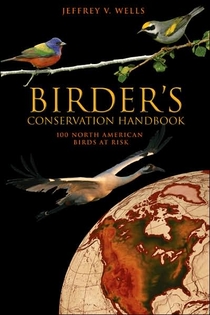Reviewed by Grant McCreary on December 19th, 2008.
According to the Birder’s Conservation Handbook, among the 100 most threatened birds in North America are the California Condor, Whooping Crane, Brown-headed Nuthatch, Kirtland’s Warbler… Wait; did that say Brown-headed Nuthatch? Sure, it has a fairly limited range and is dependent upon southern pine forests (and we know how well that has worked out for the Red-cockaded Woodpecker), but they can be seen all over where I live.
However, readers of this book will find that this endearing little bird is indeed in trouble. From 1966 to 2005, it has declined approximately 46% rangewide, mostly due to loss of habitat. This is what makes this guide so valuable. There is no other single resource that identifies this continent’s most-threatened birds, the reasons they are endangered, and what can be done about it.
Each of the 100 species accounts starts with a small black-and-white drawing of the bird and a map that shows the species’ entire range. Besides being very interesting, the latter feature is essential for a book such as this since many threats to migrants occur in their wintering range.
The text for each of the accounts is broken down into the following:
- Status and Distribution
- Ecology – includes food, breeding, and habitat requirements
- Threats
- Conservation Action – actions already taken
- Conservation Needs – a bulleted list of actions that are still needed
An extensive list of references closes out the account. It should be a great help to wildlife managers (and anyone else who wants to delve into greater detail) that the references are numbered and each section is annotated with the sources used.
The accounts run between one and a half to four and a half pages, and average about three. The level of detail on some species is astounding. For instance, an estimation of the entire population of Black-capped Vireos is given, the percentage that breed in Mexico versus the United States, along with the most important breeding areas and how many occur in each.
Make sure not to skip the expansive introduction that discusses the state of North American birds in general and outlines major conservation issues. And just in case this book inspires readers to help (and it should), the author also lists some things that everyone can do.
Finally, there are four appendices. The first is a handy list of all North American species and their conservation status as designated by different agencies (i.e. Audubon, Partners in Flight, etc). The second is a list of the endangered and extinct birds of Hawaii (sadly way too many). Up next is a list of the threatened birds of Mexico. And last is a directory of organizations involved in bird conservation.
My only disappointment is with the presentation. I was very surprised to find that there was no color. Color would help the maps, but it would have been especially nice to have a color painting or photograph of each bird. I realize, however, that the author intended this to be a handbook and not a coffee table book. Thus, I can’t fault it too much for this; it’s more of a personal preference.
Another personal issue is with the cover. It picks up and shows oil from your hands very easily. I only mention this in case anyone else is as particular as I am about keeping books as pristine as possible. I have seen another copy, though, that seemed to have a cover made of a different material, so maybe this “issue” has already been addressed.
Recommendation
Invaluable to conservation groups, and a unique resource for birders, this handbook is a critical contribution in the struggle to protect birds. It is also an eye-opener that every North American birder should have. We ought to know how a species is faring just as well as we know its field marks.
Disclosure: I get a small commission for purchases made through links in this post.





Comment